|













![Read exactly what FREE PATTERNS really means...respect our designers and authors rights [and thank you]](../images/OFFnavLEGAL.gif)



 
|
 |
 <click
for more! <click
for more!
 
|
| 
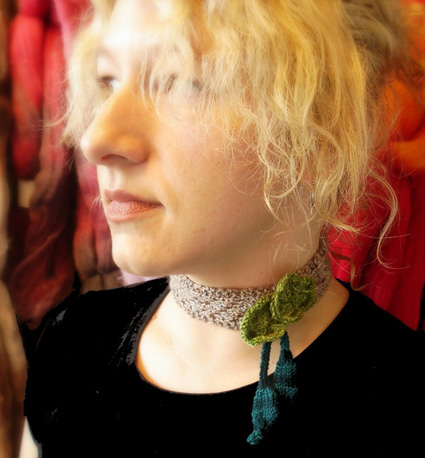  by
Larissa Brown by
Larissa Brown

Not the car. The girl.
Chevette is a somehow
tough-but-vulnerable bike messenger created
by the novelist William Gibson. She would
look adorably blunt in this girly necklace.
The necklace would do just as well with a
t-shirt as it would with a flowing summer dress.
Its strap is knitted in a simple, geometric
eyelet pattern that complements the rounded
flowers and flowing stems and leaves.
It can be made to any
length you need. Two vintage buttons hold
it closed. The “corsage” is
sewn into one removable piece, so the style
can change to super simple at a moment’s
notice. |
|
 model: Stevanie
Pico
model: Stevanie
Pico  photos: Larissa Brown
photos: Larissa Brown |
|
| |
Custom. Necklace
shown fits a 13.5-inch neck. |
Width: 1.5
inches
Length: To fit |
ShibuiKnits
Sock [100% superwash merino wool; 191 yd/175
m per 1.75 oz/50 g skein]; 1 skein each color
 [MC] #402 Sand [MC] #402 Sand
 [CCA] #7495 Wasabi [CCA] #7495 Wasabi
 [CCB]
#323 Peacock [CCB]
#323 Peacock
Recommended needle size:
 1
set US #2/2.75 mm double-point needles 1
set US #2/2.75 mm double-point needles
[always use a needle size that gives you the gauge listed below
-- every knitter's gauge is unique]
 Tapestry
needle Tapestry
needle
 Sewing needle Sewing needle
 Steam iron or clothing steamer (optional) Steam iron or clothing steamer (optional)
 2 decorative buttons, 7/8 inch diameter 2 decorative buttons, 7/8 inch diameter
 1 plain, flat button, 7/8 inch diameter 1 plain, flat button, 7/8 inch diameter
|
|
30 sts/46 rows
= 4 inches in stockinette st
Row gauge is not
critical for this project. |
| [Knitty's
list of standard abbreviations and techniques
can be found here] |
Yarn Notes
I highly recommend the listed yarn for this project because of its wonderful
springiness, tight twist, and rich colors. However, if you decide to
substitute, make sure you use a yarn with spring to it, not a fiber
like 100% cotton that has less elasticity or may be heavy.
The pattern uses a very small amount of each color. The blossoms, for example,
use approx. 8yd of CCA. You will have most of the yarn you purchase left
over to make socks or another project, such as colorwork gloves.
Abbreviations
Dvw (double vertical wrap): Bring yarn forward
between needles, down front of work, and
wrap under bottom of work. Bring yarn up
at back of work and forward between needles
again to wrap a second time, ending with
yarn at back of work, ready to knit the next
st. Be sure to knit next st snugly, to pull
wraps tight.
SKP: Sl 1, k1, pass slipped st over st just
knit.
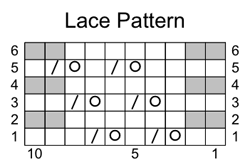 S2KP: Slip next 2 sts together, knitwise,
as if to work a k2tog. Knit next st, then pass
both slipped sts together over st just knit.
This forms a centered double decrease. S2KP: Slip next 2 sts together, knitwise,
as if to work a k2tog. Knit next st, then pass
both slipped sts together over st just knit.
This forms a centered double decrease.
Lace Pattern (Worked over 10 sts):
Row 1 [RS]: K2, yo, k2tog, k1, yo, k2tog, k3.
Rows 2, 4, 6 [WS]: K2, p6, k2.
Row 3 [RS]: K3, yo, k2tog, k1, yo, k2tog, k2.
Row 5 [RS]: K4, yo, k2tog, k1, yo, k2tog, k1.
Repeat Rows 1-6 for Lace Pattern.
I-Cord
Using a double-point needle, CO required number
of sts.
Next Row: Instead of turning work around to
work back on the WS, slide all sts to other
end of needle, switch needle back to your left
hand, bring yarn around back of work, and start
knitting the sts again. I-Cord is worked with
the RS facing at all times.
Repeat this row to form I-cord. After a few
rows, work will begin to form a tube. |
|
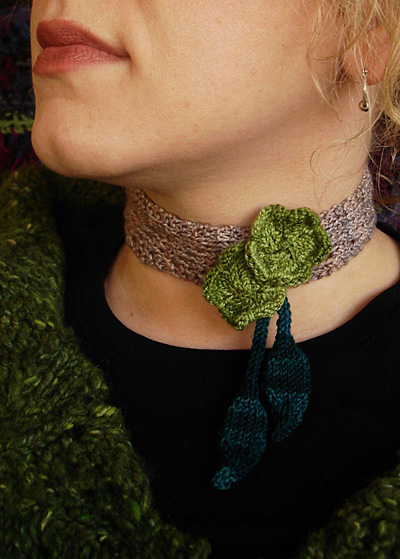  BAND BAND
Using
MC, CO 10 sts.
K 2 rows.
Work in Lace Pattern until work measures
approx. 1.5 inches less than neck circumference,
ending with Row 6 of pattern.
K 2 rows. BO all sts.
BLOSSOMS (Make 2)
Using CCA, CO 30 sts.
Rows 1, 3 [RS]: K all sts.
Rows 2, 4 [WS]: P all sts.
Row 5 [RS]: K3, dvw, [k6, dvw] to last 3
sts, k3.
Row 6 [WS]: [P2tog] 15 times. 15 sts.
Row 7 [RS]: [K2tog] 7 times, k1. 8 sts.
Row 8 [WS]: [P2tog] 4 times. 4 sts.
Row 9 [RS]: [K2tog] twice, pass first st
on right needle over second st. 1 st.
Break yarn, leaving an 8-inch tail. Draw
tail through remaining st and pull tight.
Use yarn tail to sew side edges of piece
together, forming a round flower.
VINE AND LEAF (Make 2)
Using
CCB and leaving a tail 4-6 inches long, CO
3 sts. Work I-Cord for 1 inch. Work last
row of I-Cord as follows: [K1, m1] twice,
k1. 5 sts. Turn work.
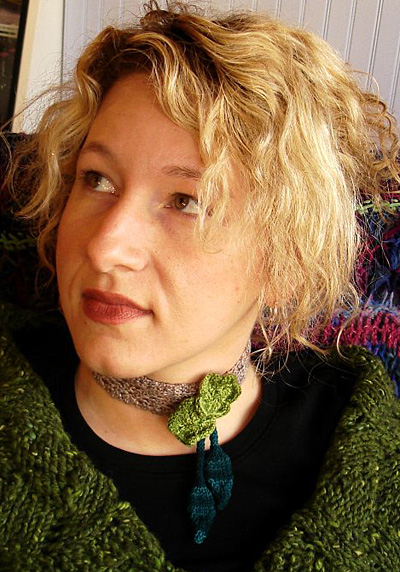  Leaf: Leaf:
Odd-Numbered Rows 1-17 [WS]: P all sts.
Row 2 [RS]: K1, m1, k3, m1, k1. 7 sts.
Row 4 [RS]: [K1, m1, k2, m1] twice, k1. 11
sts.
Rows 6, 8 [RS]: K all sts.
Row 10 [RS]: K2, SKP, k3, k2tog, k2.
9 sts.
Row 12 [RS]: K2, SKP, k1, k2tog, k2. 7 sts.
Row 14 [RS]: K2, S2KP, k2. 5 sts.
Row 16 [RS]: K1, S2KP, k1. 3 sts.
Row 18 [RS]: SK2P. Break yarn, draw through
remaining st and pull tight.
Make a second vine and leaf in the same
way, working 2 inches of I-Cord before beginning
leaf.
|
|
| 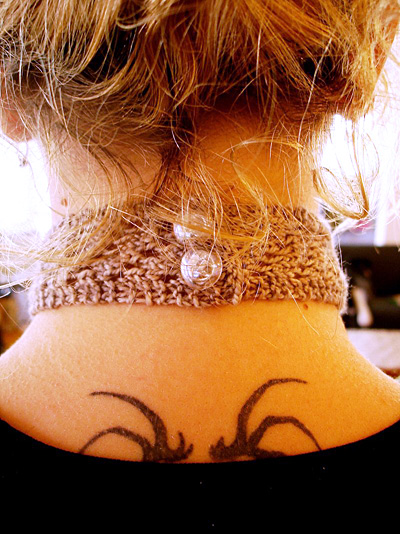  Weave in ends on
band. Weave in ends on
band.
Gently steam block or wet block band, so that
lace pattern is opened up and desired band length
(equal to neck circumference) is achieved.
Sew decorative buttons to one end of band,
opposite holes formed by lace pattern at other
end of band. (These holes will be used as buttonholes.)
Block flowers and leaves. Sew the two blossoms
together to form a corsage, then sew vines
to back of corsage, using photos as guides.
Weave in ends on corsage. Sew plain button
to back of corsage. Button corsage to band
at desired location, using a hole in the lace
pattern as a buttonhole.
|
|   Besides
knitting, Larissa likes to run, bake bread
and cake, and ride on buses and trains with
her little boy Sebastian who is 3 years old. Besides
knitting, Larissa likes to run, bake bread
and cake, and ride on buses and trains with
her little boy Sebastian who is 3 years old.
Together with her husband Martin John Brown,
Larissa recently wrote a book called Knitalong:
Celebrating the Tradition of Knitting Together. More
about the book—and a link to Larissa’s
regular knitting blog—can be found at
knitalong.net
|
| Pattern
& images © 2008 Larissa Brown. Contact Larissa |
|
|
|
|
|

